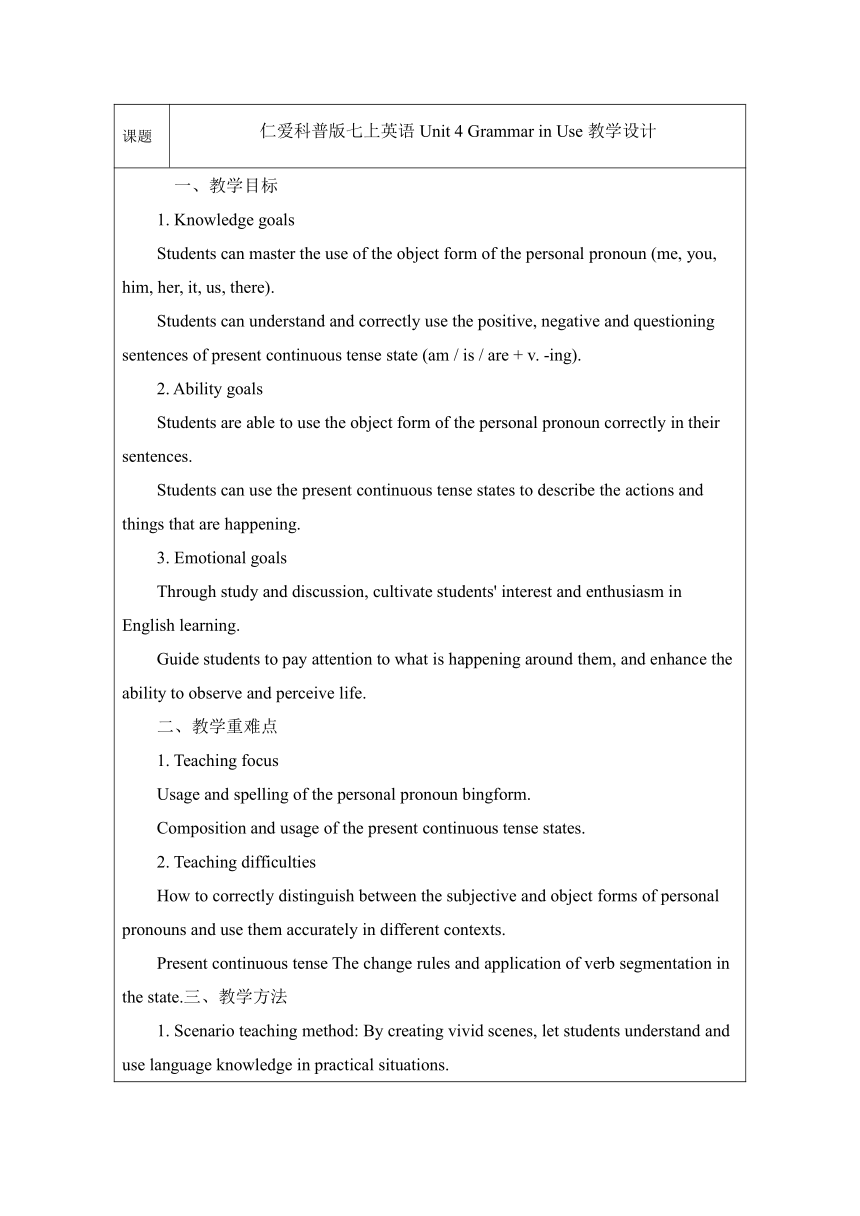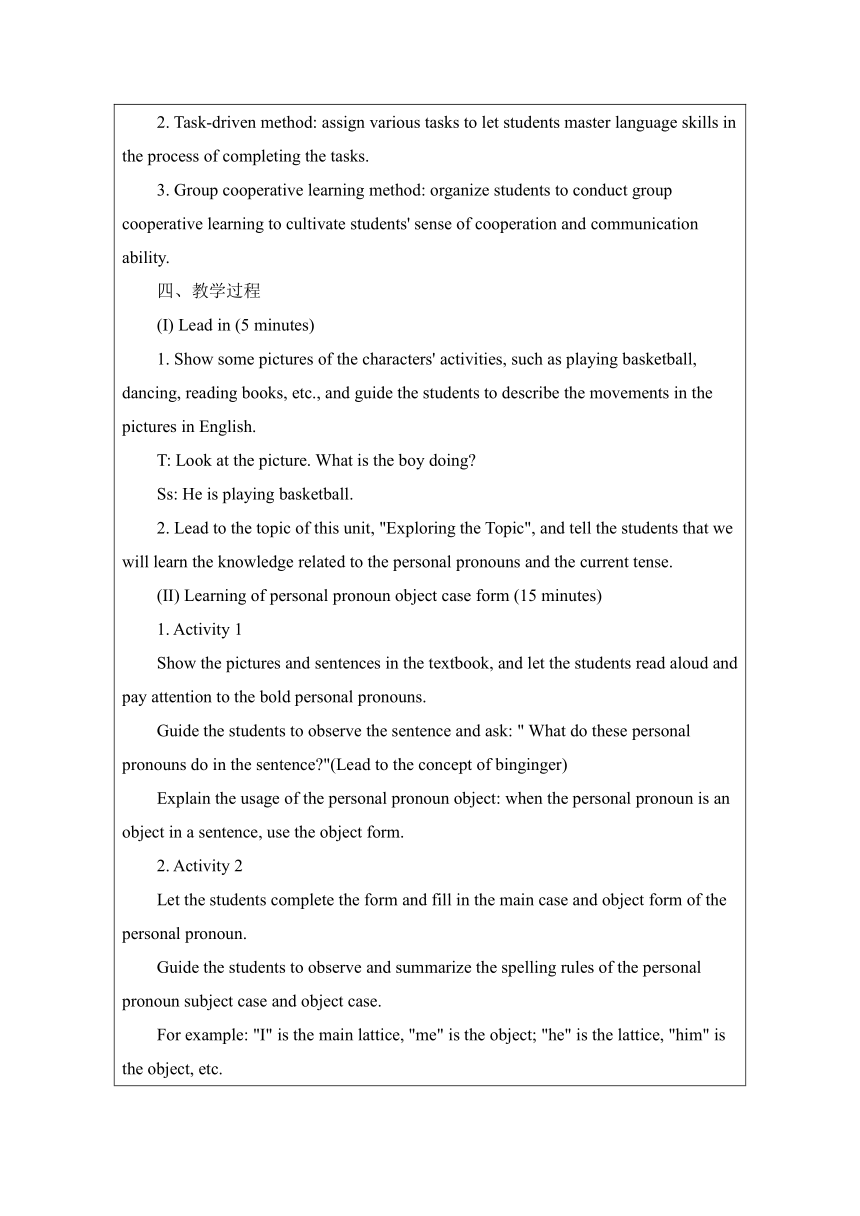仁爱科普版(2024)七上英语Unit 4 Fun in the Sun! Exploring the Topic Grammar in use 表格式教学设计
文档属性
| 名称 | 仁爱科普版(2024)七上英语Unit 4 Fun in the Sun! Exploring the Topic Grammar in use 表格式教学设计 |  | |
| 格式 | docx | ||
| 文件大小 | 24.8KB | ||
| 资源类型 | 教案 | ||
| 版本资源 | 仁爱科普版 | ||
| 科目 | 英语 | ||
| 更新时间 | 2024-12-24 13:22:09 | ||
图片预览


文档简介
课题 仁爱科普版七上英语Unit 4 Grammar in Use教学设计
一、教学目标 1. Knowledge goals Students can master the use of the object form of the personal pronoun (me, you, him, her, it, us, there). Students can understand and correctly use the positive, negative and questioning sentences of present continuous tense state (am / is / are + v. -ing). 2. Ability goals Students are able to use the object form of the personal pronoun correctly in their sentences. Students can use the present continuous tense states to describe the actions and things that are happening. 3. Emotional goals Through study and discussion, cultivate students' interest and enthusiasm in English learning. Guide students to pay attention to what is happening around them, and enhance the ability to observe and perceive life. 二、教学重难点 1. Teaching focus Usage and spelling of the personal pronoun position and usage of the present continuous tense states. 2. Teaching difficulties How to correctly distinguish between the subjective and object forms of personal pronouns and use them accurately in different contexts. Present continuous tense The change rules and application of verb segmentation in the state.三、教学方法 1. Scenario teaching method: By creating vivid scenes, let students understand and use language knowledge in practical situations. 2. Task-driven method: assign various tasks to let students master language skills in the process of completing the tasks. 3. Group cooperative learning method: organize students to conduct group cooperative learning to cultivate students' sense of cooperation and communication ability. 四、教学过程 (I) Lead in (5 minutes) 1. Show some pictures of the characters' activities, such as playing basketball, dancing, reading books, etc., and guide the students to describe the movements in the pictures in English. T: Look at the picture. What is the boy doing Ss: He is playing basketball. 2. Lead to the topic of this unit, "Exploring the Topic", and tell the students that we will learn the knowledge related to the personal pronouns and the current tense. (II) Learning of personal pronoun object case form (15 minutes) 1. Activity 1 Show the pictures and sentences in the textbook, and let the students read aloud and pay attention to the bold personal pronouns. Guide the students to observe the sentence and ask: " What do these personal pronouns do in the sentence "(Lead to the concept of binginger) Explain the usage of the personal pronoun object: when the personal pronoun is an object in a sentence, use the object form. 2. Activity 2 Let the students complete the form and fill in the main case and object form of the personal pronoun. Guide the students to observe and summarize the spelling rules of the personal pronoun subject case and object case. For example: "I" is the main lattice, "me" is the object; "he" is the lattice, "him" is the object, etc. 3. Practice consolidation Give some sentences, let the students choose the correct personal pronoun object form to fill in the blanks. For example: the Please give the book to ____. (he / him) (III) Learning of present continuous tense state (20 minutes) 1. Activity 1 Show more pictures and sentences of present continuous tense states, and let the students observe and read them aloud. Guide the students to pay attention to the structure of "am / is / are + v. -ing" and explain the meaning of present continuous tense state: indicate the ongoing action. 2. Activity 2 Let the students read the sentences, complete the table, and summarize the composition of the positive sentences and negative sentences in the present continuous tense state. Emphasize that the use of be verb (am / is / are) should vary according to the subject. 3. The rules of verb segmentation Explain the changing rules of the verb, such as generally add-ing, add the verb ending with the silent e, remove e and add-ing, read the verb ending with the closed sound, double write the end letter and add-ing, etc. Examples: play playing; write writing; run running 4. Practice consolidation Give some verbs and ask the students to write their current segmentation form. Give some sentences and let the students rewrite them in the present continuous tense state. (IV) Comprehensive exercise (15 minutes) 1. Let the students read a short essay and fill in the blanks in the form of the given personal pronoun and the present tense. For example: My friend and I are in the park. We are having a good time. I am flying and he is playing football. Look at the girls over there. They are singing and dancing. We all like ___ (it) very much. 2. Group activities Let the students group in groups, describe what the group members are doing in present continuous tense, and then each group to report to the class. (V) Summary and homework assignment (5 minutes) 1. Summarize the key content of this lesson: the usage of the personal pronoun object form and the composition and usage of the current tense. 2. Assign your homework Write a short essay in present continuous tense form describing what your family or friends are plete the relevant exercises in the textbook. 五、教学反思 Through the teaching of this lesson, students have a preliminary understanding of the object form and present continuous tense state of personal pronoun. In the teaching process, more situations should be created to let the students master the language knowledge in the practical application. At the same time, we should strengthen the practice guidance for students, correct students' mistakes in time, and help students consolidate what they have learned.
一、教学目标 1. Knowledge goals Students can master the use of the object form of the personal pronoun (me, you, him, her, it, us, there). Students can understand and correctly use the positive, negative and questioning sentences of present continuous tense state (am / is / are + v. -ing). 2. Ability goals Students are able to use the object form of the personal pronoun correctly in their sentences. Students can use the present continuous tense states to describe the actions and things that are happening. 3. Emotional goals Through study and discussion, cultivate students' interest and enthusiasm in English learning. Guide students to pay attention to what is happening around them, and enhance the ability to observe and perceive life. 二、教学重难点 1. Teaching focus Usage and spelling of the personal pronoun position and usage of the present continuous tense states. 2. Teaching difficulties How to correctly distinguish between the subjective and object forms of personal pronouns and use them accurately in different contexts. Present continuous tense The change rules and application of verb segmentation in the state.三、教学方法 1. Scenario teaching method: By creating vivid scenes, let students understand and use language knowledge in practical situations. 2. Task-driven method: assign various tasks to let students master language skills in the process of completing the tasks. 3. Group cooperative learning method: organize students to conduct group cooperative learning to cultivate students' sense of cooperation and communication ability. 四、教学过程 (I) Lead in (5 minutes) 1. Show some pictures of the characters' activities, such as playing basketball, dancing, reading books, etc., and guide the students to describe the movements in the pictures in English. T: Look at the picture. What is the boy doing Ss: He is playing basketball. 2. Lead to the topic of this unit, "Exploring the Topic", and tell the students that we will learn the knowledge related to the personal pronouns and the current tense. (II) Learning of personal pronoun object case form (15 minutes) 1. Activity 1 Show the pictures and sentences in the textbook, and let the students read aloud and pay attention to the bold personal pronouns. Guide the students to observe the sentence and ask: " What do these personal pronouns do in the sentence "(Lead to the concept of binginger) Explain the usage of the personal pronoun object: when the personal pronoun is an object in a sentence, use the object form. 2. Activity 2 Let the students complete the form and fill in the main case and object form of the personal pronoun. Guide the students to observe and summarize the spelling rules of the personal pronoun subject case and object case. For example: "I" is the main lattice, "me" is the object; "he" is the lattice, "him" is the object, etc. 3. Practice consolidation Give some sentences, let the students choose the correct personal pronoun object form to fill in the blanks. For example: the Please give the book to ____. (he / him) (III) Learning of present continuous tense state (20 minutes) 1. Activity 1 Show more pictures and sentences of present continuous tense states, and let the students observe and read them aloud. Guide the students to pay attention to the structure of "am / is / are + v. -ing" and explain the meaning of present continuous tense state: indicate the ongoing action. 2. Activity 2 Let the students read the sentences, complete the table, and summarize the composition of the positive sentences and negative sentences in the present continuous tense state. Emphasize that the use of be verb (am / is / are) should vary according to the subject. 3. The rules of verb segmentation Explain the changing rules of the verb, such as generally add-ing, add the verb ending with the silent e, remove e and add-ing, read the verb ending with the closed sound, double write the end letter and add-ing, etc. Examples: play playing; write writing; run running 4. Practice consolidation Give some verbs and ask the students to write their current segmentation form. Give some sentences and let the students rewrite them in the present continuous tense state. (IV) Comprehensive exercise (15 minutes) 1. Let the students read a short essay and fill in the blanks in the form of the given personal pronoun and the present tense. For example: My friend and I are in the park. We are having a good time. I am flying and he is playing football. Look at the girls over there. They are singing and dancing. We all like ___ (it) very much. 2. Group activities Let the students group in groups, describe what the group members are doing in present continuous tense, and then each group to report to the class. (V) Summary and homework assignment (5 minutes) 1. Summarize the key content of this lesson: the usage of the personal pronoun object form and the composition and usage of the current tense. 2. Assign your homework Write a short essay in present continuous tense form describing what your family or friends are plete the relevant exercises in the textbook. 五、教学反思 Through the teaching of this lesson, students have a preliminary understanding of the object form and present continuous tense state of personal pronoun. In the teaching process, more situations should be created to let the students master the language knowledge in the practical application. At the same time, we should strengthen the practice guidance for students, correct students' mistakes in time, and help students consolidate what they have learned.
同课章节目录
